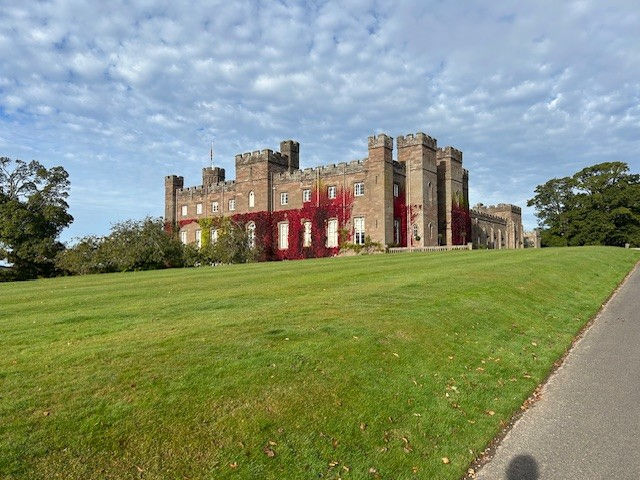Scone Palace Is A Living Legacy of History, Kingship and Continuity
- Linda Andrews - Editorial Assistant, Family Business United

- Sep 30
- 4 min read

Nestled above the winding River Tay, overlooking the ancient city of Perth and framed by the distant Grampian Mountains, lies Scone—a place unlike any other in Scotland. Today, in the 21st century, it is home to the Earls of Mansfield and a living monument to the past. Revered as The Crowning Place of Scottish Kings, Scone is steeped in a history that stretches across millennia, and a quintessentially Scottish Palace that has been in the family for over 400 years.
From Pagan Hill to Christian Sanctuary
Long before the pomp and ceremony of coronations, Scone was a site of strategic and spiritual importance. Two thousand years ago, Roman legions camped on these banks, marking the furthest northern edge of their empire. But it was the Picts—fierce, enigmatic, and famously painted—who ruled these lands, eventually establishing Scone as their royal seat.
By the early 7th century, Christian influence had taken root, thanks to the missionary efforts of St Columba’s followers. These early Christians, known as the Culdees or ‘Servants of God’, founded a monastic community at Scone, setting the stage for its future as both a spiritual and political hub.
The Birthplace of a Nation
In 843, a turning point in Scottish history took place when Kenneth MacAlpin, King of the Scots, united the warring Picts and Scots under his rule. Tradition holds that he brought with him the Stone of Destiny—the symbolic seat of royal authority—and placed it atop Moot Hill, where generations of monarchs would follow in his footsteps.
Scone’s role as the heart of the Scottish realm was confirmed in 906, when King Constantine II held the first recorded council here—a precursor to the medieval parliaments that would shape the nation until the 15th century.
Throughout the centuries, this ground bore witness to a turbulent succession of power struggles. Macbeth and his rival Malcolm Canmore both ruled from Scone. In 1292, John Balliol was crowned here under the eye of Edward I, only to rise in rebellion four years later. The resulting English invasion saw the Stone of Destiny seized and taken to Westminster Abbey, where it remained for over 700 years.
Then, in 1306, Robert the Bruce was crowned at Scone—his hands still stained with the blood of his slain rival, the Red Comyn—marking another dramatic chapter in the nation’s saga.
A Royal Abbey in Ruins
Scone was not only a place of kings, but also a sacred religious centre. In 1114, Alexander I established an Augustinian priory beside Moot Hill. By 1169, the priory had become a full abbey, befitting a place of such national significance. Here in 1249, Alexander III was the first Scottish king to be formally crowned, and in 1329, a Papal Bull granted David II the right to be anointed with holy oil.
But Scone was not immune to the sweeping tides of political and religious upheaval. During the Reformation, in 1559, an angry mob from Dundee attacked the abbey. Despite John Knox’s efforts to intervene, the building was destroyed. By 1580, the lands had passed to the powerful Ruthven family, who restored the ruins and rebuilt the abbey palace.
However, following the mysterious Gowrie Conspiracy of 1600, the Ruthvens fell from grace. Their estates were confiscated and handed to Sir David Murray of Gospetrie—an ancestor of today’s Earls of Mansfield—marking the beginning of a new chapter for Scone.

The Gothic Revival and Royal Visits
In 1803, the 3rd Earl of Mansfield began transforming the medieval house into the magnificent Gothic Revival palace we see today. His vision came to life under the guidance of architect William Atkinson, creating a stately home fit for royalty. Indeed, in 1842, Queen Victoria was received here during her historic journey to the Highlands.
Since then, Scone Palace has welcomed a distinguished array of guests, including Queen Elizabeth The Queen Mother—childhood friend of a later Earl of Mansfield—Queen Elizabeth II, and even the Emperor of Japan.
The Murrays of Scone: Guardians of a Legacy
The Murray family, whose name echoes across centuries of Scottish history, have long been at the heart of national affairs. Their lineage traces back to Freskin de Moravia, a 12th-century Flemish noble granted lands near Inverness—today’s Moray. From him descend both the Earls of Mansfield and the Dukes of Atholl.
Following the Gowrie Conspiracy, Sir David Murray was rewarded not only with the Scone estate, but later the title Lord Scone, and then Viscount Stormont in 1621. Though childless, his titles passed to another branch of the family, securing the Murrays’ lasting presence at Scone.
Statesmen, Soldiers and Jacobites
The 18th century saw the Murrays embroiled in the Jacobite uprisings. The 5th Viscount Stormont hosted the Old Pretender at Scone in 1715, a costly show of loyalty that led to imprisonment and heavy fines. Thirty years later, the Young Pretender was welcomed by the family once more.
Meanwhile, their brother William Murray rose to become Lord Chief Justice of England, earning fame as a legal reformer and fierce defender of civil liberties. During the anti-Catholic Gordon Riots of 1780, his London home was torched by the mob, who also threatened Kenwood House in Hampstead, which he had purchased from the 3rd Earl of Bute.
William was later ennobled as Earl of Mansfield, creating a title that has since passed through generations of Murrays, including diplomats, politicians, and legal minds.
A Living Heritage
From courtroom to Crown Estate, the Murrays continued their public service into the modern age. The 8th Earl of Mansfield served as a barrister, MEP, and later as Minister of State for both Scotland and Northern Ireland before becoming First Crown Estate Commissioner.
Today, Alexander Murray, 9th Earl of Mansfield, lives at Scone Palace with his wife and four children, continuing a legacy that spans over 400 years. Far more than a stately home, Scone remains a vibrant, living tribute to Scotland’s royal and national identity—where kings were crowned, laws were forged, and history was made.








%20copy%20(4)%20copy%20(1)%20copy%20copy%20(1)%20copy%20(1)-Medium-Quality.jpg)



.png)
























